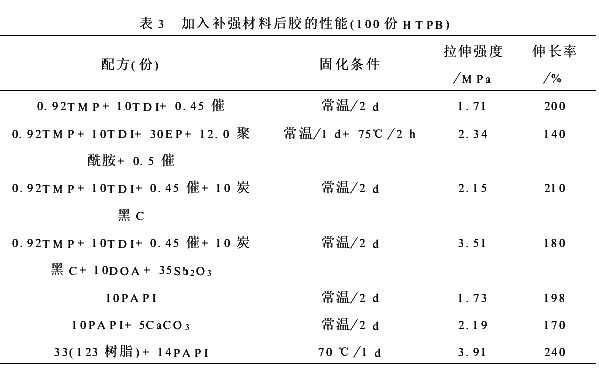The samples were prepared with 0.92 TMP+10TDI+0.45 catalyst (100 parts of HTPB in butyl hydroxydiene, cured at room temperature for 2 days). The tensile strengths were 1.39 and 1.71 MPa, respectively, under different vacuum and vacuum processing conditions. It is 121% and 200%. It can be seen that the tensile strength and elongation of the vacuum-treated rubber are greatly improved. This is because the vacuum-free adhesive contains a large number of bubbles, and the cured adhesive is equivalent to a foam material, and has a low density and therefore low strength.

2.4 The performance of rubber after adding reinforcing material
Adding 30 parts of epoxy resin to 100 parts of HTPB, its strength increased by about 40%, but its enthalpy growth rate decreased by 30% (as shown in Table 4), and its operating time became shorter, indicating that polyamide was used as a curing agent. The reaction speed is fast and the operation time is short. At the same time, due to the epoxy resin curing too fast, the styrene hydroxy adhesive and the epoxy phase separation are caused, so that the strength of the adhesive is not fully improved, and other curing agents must be considered. Phosphoric acid is currently used to ring-open epoxy to form hydroxyl groups. Then TDI is used to simultaneously cure butyl hydroxy paste, epoxy, and butyl hydroxy glue is grafted and cured with epoxy to fully increase the strength of the blend and maintain its elongation. Work is currently in progress. If 10 parts of DOA plasticized are added, 10 parts of carbon black and 35 parts of Sb2O3 can be added to increase the strength, and the process performance can meet the need of casting. The addition of 33 parts of 123 resin will greatly increase the tensile strength and elongation. 123 resin, butyl hydroxy glue can be cured by PAPI at the same time, to enhance the butyl hydroxy glue; at the same time due to the grafting and chain expansion caused by curing, so that its elongation increased. After adding 5 parts of nano-CaCO3, the adhesive strength also increased, but it was not significant, and the elongation decreased by 15%, indicating that the nano-material has poor reinforcing effect on the adhesive.
3 Conclusion
1) In the presence of catalyst, using TDI and TMP curing, the temperature has no significant effect on adhesive strength; with MDI and TMP, PAPI curing, the strength and elongation increase significantly, its strength is similar to that of TDI, but it is easy to operate.
2) increase the amount of curing agent, adhesive strength, elongation decreased; using vacuum processing, can greatly improve the adhesive strength.
3) Adding epoxy, carbon black, Sb2O3 and nano-materials can increase the strength of the adhesive and reduce the elongation.
4) The addition of carbon black, DOA, Sb203, 123 resin can greatly increase the strength and elongation.
Source: 21st Century Fine Chemicals Network
Hair Growth,Hair Growth Serum,Hair Serum Roller,Organic Hair Serum
Guangzhou Yilong Cosmetics Co., Ltd. , https://www.skinmelao.com